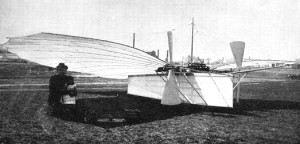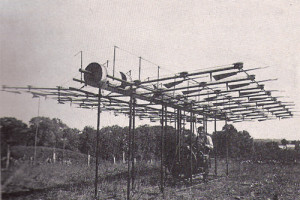Whitehead’s successful flights were made with his “Condor” design, known as No.’s 21 (Aug. 1901) and 22 (Jan. 1902, an improved version of No. 21), often referred to as the “bat-winged design”, under development for several years prior to the flights. He used these prototypes to test his theories, which were successful, and have been proven airworthy in modern-day tests of replicas. His early 1901-1902 designs flew successfully and this is what Whitehead should be credited for.
- Funding issues– These planes were developed using funding Whitehead obtained from several sources – his own funds, funds from a few friends, and sponsors who allowed him freedom in his designs. Following this period, Whitehead never again obtained adequate funding in order to fully expand his theories. With a growing family that soon included four children, he turned to building airplanes and lightweight airplane motors for others, including Charles Wittemann, who later referred to Whitehead as “a genius”. By contrast, Wilbur Wright was known to have said, “I cannot afford both a wife and a flying machine!” For Whitehead, a wife, four kids, AND at least one flying machine always being upgraded could be costly. Even the least expensive flying machine could cost $1000, which is $26,315.79 in 2013. Whitehead made fraction of that as a factory worker, likely making less than $500 a year in 1901 (non-farm worker). Anton Pruckner, Whitehead’s assistant, said he made 10-15 cents per hour, working ten hour days, six days a week in Bridgeport’s factories, where Whitehead also worked, in the years 1900 – 1902. These two men struggled to save enough out of their minute pay, living in the most austere conditions, to develop the first airplane that all others are modeled after.
- Business issues with his early sponsors and later customers continued to interfere with his inventing, sometimes involving loss of his inventions and even his entire workshop, which was taken from him in a lawsuit in 1911. Inventing was Whitehead’s strong suit. Business was not!
- Motivation – According to one of his key mechanics and his brother, when Whitehead learned of the Wrights’ flights at Kitty Hawk, this came as a major blow to his motivation and drive, for a variety of reasons, including what he viewed as the loss of his own inventions to the Wrights.
- Patent issues – Early patent issues included problems filing for a patent before the Wrights did; later patent issues included inability to use vital elements of his own inventions due to the Wright patents
- Whitehead wanted to develop commercially viable airplanes – The record shows that Whitehead believed that No. 21 and 22 showed that flight was possible, but he did not consider the designs to be practical nor commercially viable. At the same time, he never obtained sponsors to fund further development of his own commercially viable, practical design ideas, past Spring of 1902.
- Belief in a plane that would rise vertically – Living in a time when there were no airports or runways, and in a populated area, the special needs required in order to conduct safe takeoffs and landings were considered impractical. Therefore, along with many of his contemporaries, Whitehead believed that the ultimate solution, to be truly practical, would be a plane that rose and landed vertically. With what little funds he could put together over the next ten years for his own designs, there is some evidence he continued to work toward this end.
Due to the broadening of the “pioneer invention” [“first” airplane] patent, the Wrights could sue anyone building a plane for profit if they used control systems that utilized warping of the wings, ailerons, or horizontal surfaces. This severely limited Whitehead and other inventors of the era, who were building airplanes for commercial purposes.
In Whitehead’s case, his early, successful plane designs utilized wing-warping, horizontal surfaces, and ailerons, predating the Wrights, but he did not patent these in time, due to financial constraints. The Wrights patented wing-warping first, and the rest is history. It should be noted that a number of witnesses swore in affidavits that the Wright brothers visited Whitehead at his shop on more than one occasion, during his early, successful years, and before they filed a patent. Both parties were also affiliated with Stanley Yale Beach, aviation editor of the Scientific American, who could easily have transmitted information about Whitehead’s early, successful control systems, according to one school of thought. These little-known aspects have been part of the earliest controversies. The loss of ability to utilize his own inventions without being considered an infringer was one factor that impacted Whitehead’s morale and ability to continue successful development of a practical plane, according to those close to him.
A combination of all these factors and later physical and health issues (due to factory accidents he became blind in one eye, was hit in chest causing angina; had an airplane accident which caved in ribs and caused unconsciousness) contributed to preventing Whitehead from further development of his designs. Scattered reports of flights occurred in 1903 and again in 1908, but never to the degree of his successes of 1901-1902.
None of the above detract from Whitehead’s earlier successes, which demand recognition, and his successful theories of flight, upon which modern aircraft are based.
Caution Needed When Evaluating “Historian” Credentials and Whitehead Research
Past Whitehead researchers, while not professional historians, were careful to document Whitehead’s accomplishments using multiple sources to cross-check the information they received. They took time to examine the data, cited their sources, and issued findings that were credible, as a result. Professional, trained historians with credentials and degrees, unfortunately produced the commonly accepted view of the early aviation historical record in a biased or poorly informed manner. This has created a crisis with regards to the veracity of the “research” and information pertaining to “first flight”. The professional historians have been unable to issue findings that counter what Smithsonian’s biased pronouncements have produced, while self-appointed “historians” have filled this void by conducting “research” that must be closely examined in a non-biased manner. Finding non-biased professional historians is next to impossible on this topic, however. Since Smithsonian and its 200 affiliates dominate the professional historian environment, worldwide, financially and politically, and are bound by contract to uphold the Wrights as first in flight, this has undermined the normal process.
It is important to recognize the contributions of past researchers of Whitehead, the foundation for his current credit. Credit is due to Maj. William J. O’Dwyer and Stella Randolph, whose combined 80 years of research is rarely cited today as the sole source of credible information. The basis of any new findings should be, appropriately, rigorously evaluated and debated. The use of the term “aviation historian” is being bandied about and assumed by those without professional training, on both sides of the controversy. Credentials and background for those claiming to be professional aviation historians should be published and demanded by editors of newspapers and producers of documentaries, with a full academic Curriculum Vitae naming the schools and related degrees obtained, including a full and detailed employment history. One need not be an aviation historian to learn about Whitehead and privately research his accomplishments. If one is an amateur aviation historian, a hobbyist, that should also be stated. Research is another term that must be examined. Original research, field research, and personal research about Whitehead are areas to sort out. Professional historians are expected to provide their own related credentials, using citations and sources for their work. This has been lacking with some of those engaging in the heated and sometimes acrimonious debate over Whitehead as “first in flight” that is currently going on. A healthy, transparent, and professional debate is encouraged. In this manner, information may be examined in a manner that is likely to produce an accurate history. On the other hand, anything less is likely to cast a shadow on the entire research effort, to date.


